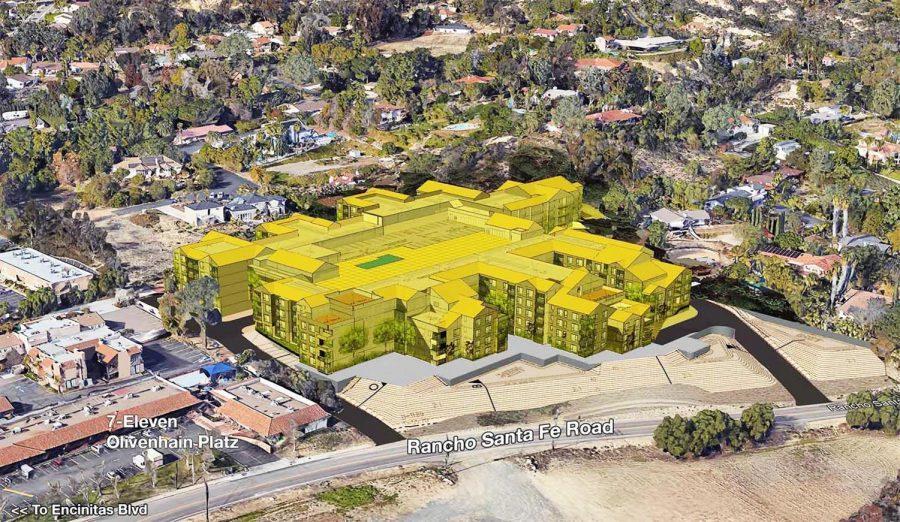Encinitas group continues watchdog role over planned apartment complex
Organization seeks county review of Olivenhain project
An Encinitas Residents for Responsible Development rendering shows the placement of the proposed Encinitas Boulevard Apartments in Olivenhain. (ERRD image)
July 11, 2022
Encinitas Residents for Responsible Development is calling for the county to lead a thorough, multidisciplinary analysis of a multi-housing development plan that the city of Encinitas has refused to complete following its third lawsuit against the city.
The organization’s main concern is the lack of affordable housing in Encinitas. While developers sold local government officials on the promise of thousands of homes in rural north and east San Diego County, those homes are not inclusive of lower-income families, critics say.
The Encinitas City Council approved developer Randy Goodson’s amended application and density bonus request for Encinitas Boulevard Apartments on June 8 after a year of resubmitting a multi-housing development plan for the complex along Encinitas Boulevard in Olivenhain, often referred to as the Goodson Project.
The organization has expressed concerns about the apartment project’s affects on fire safety and traffic in the Olivenhain community.
“Last Fall, the city failed to conduct any analysis of the adverse impacts on the public that could be caused by the Project,” Encinitas Residents for Responsible Development stated in a press release. “Encinitas Fire dismissed, without analysis, the risk this Project poses to public safety, particularly during wildfire as extensively documented by public testimony and multiple expert assessments.”
Encinitas Residents for Responsible Development proposes:
Planning and building appropriately sized developments with established transportation corridors.
Analyzing financial and environmental impacts and requiring deed-restricted projects that maximize affordable housing return for taxpayer subsidies.
Considering nonprofit development of affordable housing.
In the past, R-30 residential zoning has led to disastrous projects that maximize developer profits rather than the crucial need for affordable housing, critics argue. New projects have claimed the status to avoid environmental review and offer properties to families making $60,000-$80,000 per year, which often goes to investors who deplete the stock of affordable housing.
Encinitas Residents for Responsible Development wants the city to enter into binding agreements with developers who will build projects that match housing needs, such as housing for families making less than $50,000 per year, and undergo robust environmental review rather than resorting to R-30 zoning, which has failed in the past.
The California Housing Accountability Act required the city to approve the Goodson Project due to the desperate need for housing.
“When this project came back around for reconsideration, City Council knew how unpopular the project was, and the communities’ serious concerns with putting a 6-story building (the tallest in Encinitas) in the heart of rural Olivenhain, with the massive GHG emissions and traffic congestion from 1500 daily car commutes to job centers on I-5 South and public schools North via the heavily congested Rancho Sante Fe Road, and most importantly the public safety hazard to wildfire evacuation and emergency response times,” stated Daniel Vaughn, president of Encinitas Residents for Responsible Development.
On March 24, the California Attorney General’s Office issued a letter promising to take action against the city should it fail to pass a modified version of the Goodson Project in Olivenhain.
“Local governments must approve housing developments that comply with ‘applicable, objective general plan, zoning, and subdivision standards and criteria’ unless they make certain findings,” Attorney General Rob Bonta stated in a letter to the Olivenhain Town Council Board of Directors.
The original proposal for the Olivenhain apartments included 241 market-rate units and 42 units for lower-income individuals. At a City Council meeting on June 8, Encinitas Boulevard Apartments presented project revisions to reduce the total acreage from 6.95 acres to 6.83 acres and reduce the total number of market-rate units to 236 and affordable units to 41.
Encinitas residents have also voiced concern for public safety due to potential wildfire risk. The state attorney general, however, cited the Encinitas Fire Department in finding that the project posed no public safety issue.
“We understand that the location and structure of this single development does not pose a wildfire ignition risk, and the Encinitas Fire Department concluded that fire evacuation was not a problem. Therefore, this concern does not provide a basis for rejecting this Project,” the attorney general stated in his letter.
Given the attorney general’s position and the city’s move to green-light the project, protests are no longer enough, Vaughn said.
“The time for protests and rallies is long past; our last line of defense is litigation,” Vaughn stated.
Encinitas Residents for Responsible Development and the Olivenhain Town Council have sent letters to Attorney General Rob Bonta to voice that neither the city of Encinitas nor the Fire Department have conducted meaningful analyses of the potential threats the project would pose to public safety during wildfire evacuation.
The group is calling on Encinitas constituents to write county Supervisor Terra Lawson-Remer, who is also a local resident, to request that she direct county staff members to conduct the necessary analysis for the Goodson Project.
Samantha Cox is a local freelance writer.
encinitas current, cardiff current





